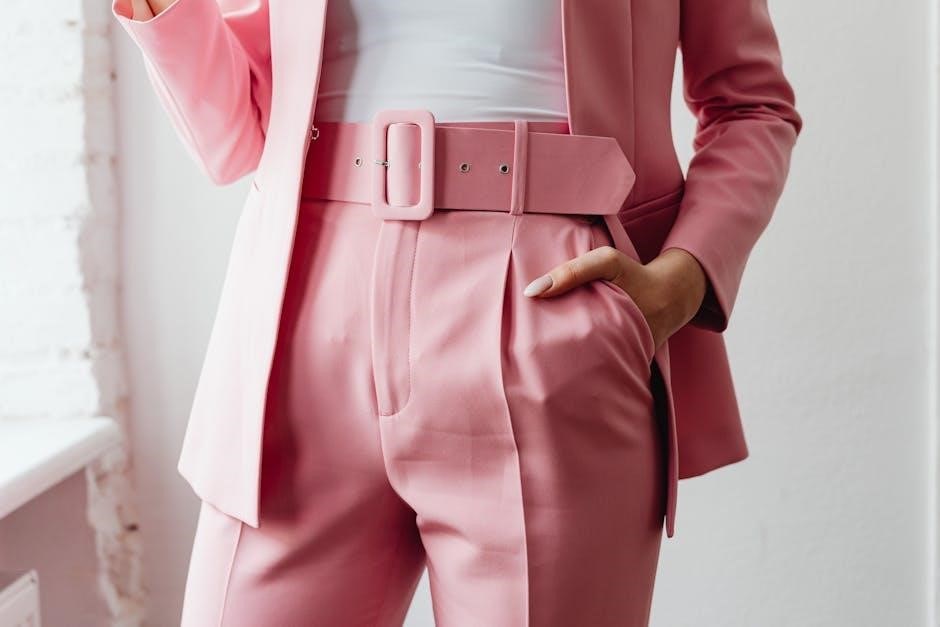This guide helps women find their perfect fit by providing detailed size charts, body measurements, and style considerations, ensuring a flattering and comfortable wardrobe choice every time.
Understanding the Importance of Proper Sizing in Women’s Clothing
Proper sizing in women’s clothing is essential for both comfort and confidence. Ill-fitting garments can lead to discomfort, restricted movement, and an unflattering appearance. Accurate sizing ensures clothes draping naturally on the body, enhancing the wearer’s silhouette and boosting self-assurance. Variations in sizing standards across brands and styles make it crucial to rely on body measurements rather than general size labels. Understanding your measurements helps navigate size charts effectively, reducing the risk of poor fit. Additionally, proper sizing impacts the durability of clothing, as garments that fit well experience less strain. Whether shopping online or in-store, taking the time to measure and compare sizes ensures a better fit, making proper sizing a cornerstone of a satisfying wardrobe experience;
- Poor fit can cause discomfort and restrict movement.
- Accurate sizing enhances appearance and confidence.
- Measurements are key due to varying brand standards.
Investing time in sizing ensures comfort, style, and satisfaction.
Measurement Guidelines for Women’s Clothing
Accurate measurements are crucial for a perfect fit. Measure your bust, waist, and hips using a flexible tape measure, keeping it level and not too tight for precise results.
- Bust: Measure around the fullest part.
- Waist: Measure at the narrowest point.
- Hips: Measure 7-9 inches below the waistline.
How to Accurately Measure Your Bust, Waist, and Hips
To ensure accurate measurements, use a flexible tape measure and stand up straight. For the bust, measure around the fullest part, keeping the tape level and parallel to the floor. For the waist, measure at the narrowest point, typically just above the belly button, with your arms relaxed by your sides. For the hips, measure 7-9 inches (18-23 cm) below the waistline, circling the widest part of your hips and buttocks. Make sure the tape is not too tight or too loose. Take measurements over the undergarments you normally wear for the best fit. If possible, have someone assist you to ensure accuracy. Repeat the measurements periodically, as body changes can affect your size. These precise measurements will help you select the correct size from the chart, ensuring a flattering and comfortable fit.
Standard Women’s Clothing Size Chart
This chart provides body measurements in inches and centimeters, correlating with standard US women’s clothing sizes. If measurements fall between sizes, select the larger size for the best fit.
US Size Chart with Body Measurements in Inches and Centimeters
The US size chart for women’s clothing provides a standardized guide for selecting the right fit. Below is a detailed chart comparing body measurements in inches and centimeters to US clothing sizes:
| Size | Bust | Waist | Hips |
|---|---|---|---|
| 00 | 28-30″ | 22-24″ | 30-32″ |
| 0 | 30-32″ | 23-25″ | 32-34″ |
| 2 | 32-34″ | 25-27″ | 34-36″ |
| 4 | 34-36″ | 27-29″ | 36-38″ |
| 6 | 36-38″ | 29-31″ | 38-40″ |
| 8 | 38-40″ | 31-33″ | 40-42″ |
| 10 | 40-42″ | 33-35″ | 42-44″ |
| 12 | 42-44″ | 35-37″ | 44-46″ |
Measurements are in inches (“) and centimeters (cm). If your measurements fall between sizes, consider selecting the larger size for a comfortable fit.

International Size Conversions
Understand how US sizes translate to UK, EU, French, Italian, Japanese, and Australian sizes for seamless global shopping, ensuring the perfect fit across international clothing brands.
Converting US Sizes to UK, EU, and Other International Sizes
Converting US sizes to international standards like UK, EU, French, Italian, Japanese, and Australian sizes is essential for global shopping. A US size 0 corresponds to a UK size 4, EU size 30, French size 32, and Italian size 36. Similarly, a US size 2 aligns with a UK size 6, EU size 32, French size 34, and Italian size 38. This pattern continues, with each US size increasing by 2 in the UK and by 2 in the EU. For example, a US size 10 matches a UK size 14, EU size 40, French size 42, and Italian size 44. These conversions ensure consistency across brands worldwide. When shopping internationally, refer to detailed size charts to match your US measurements with the equivalent UK, EU, or other sizes for a perfect fit. Always check the specific brand’s size guide, as variations may occur.

Fabric and Fit Considerations
Fabric types and garment styles affect sizing choices. Stretchy materials may require smaller sizes, while non-stretch fabrics demand precise measurements. Fit preferences, like relaxed or fitted silhouettes, also influence size selection based on fabric stretch.
How Fabric Type and Style Affect Size Selection
Fabric type and garment style significantly influence size selection in womenswear. Stretchy fabrics, like knits, allow for flexibility, potentially enabling a smaller size, while non-stretch fabrics, such as cotton or linen, require precise measurements; Garment styles, like fitted dresses or loose tunics, also impact fit. For example, a fitted dress may require exact measurements, while a tunic can be more forgiving. Additionally, the drape and weight of fabric affect how clothing sits on the body. Lighter fabrics may cling more, necessitating careful size choices, while heavier fabrics can create structure without hugging the body. Understanding these factors helps in selecting sizes that balance comfort and aesthetics. Always consider fabric content and style when choosing sizes to ensure the best fit.

Choosing the Right Size Based on Body Type
Understand your body shape—pear, hourglass, rectangular, or apple—to select flattering sizes. Pear-shaped? Highlight hips. Hourglass? Balance bust and hips. Rectangular? Define waist. Apple-shaped? Opt for V-necks.
Understanding Your Body Shape and Selecting Flattering Sizes
Knowing your body shape—pear, hourglass, rectangular, or apple—helps you choose flattering styles. Pear-shaped women have curves in the hips and thighs, while hourglass figures balance bust and hips. Rectangular body types have similar measurements across bust, waist, and hips, and apple-shaped individuals carry weight around the midsection. For pear-shaped, A-line dresses and high-waisted pants create balance. Hourglass figures look great in fitted waists and V-necks. Rectangular shapes benefit from belted jackets or ruffled tops to add curves. Apple-shaped women should opt for V-necks and empire-waist dresses to draw attention away from the midsection. Understanding your silhouette ensures a more tailored and confident wardrobe choice. Use size charts to align your measurements with styles that enhance your natural curves for a polished, put-together look. Always measure accurately and consider fabric drape when selecting sizes for the best fit.

Seasonal and Brand Variations in Sizing
Brands and seasons often vary in sizing due to design trends or fabric types. Always check the specific size chart for each brand and collection to ensure the best fit.
How Sizing Can Vary Between Brands and Seasons
Brands often have unique sizing standards, leading to variations in fit. Some brands may cater to specific body types or follow different measurement guidelines, making sizes inconsistent across labels. Seasons also influence sizing, as designs may prioritize comfort or style over strict measurements. For example, summer collections might feature looser fits, while winter styles could be more tailored. Additionally, fabric types and stretch can affect how garments fit, even within the same size. It’s common for sizes to differ slightly between brands, so relying on a single size chart may not always work. To navigate this, it’s essential to consult the specific size guide for each brand and collection. This ensures the best fit, especially when shopping across different labels or seasons.
